Etherley Incline
1825-1843
(Written following a walk down the Etherley incline 14th
October 2011)
(Updated 9th December 2013 after reading "Rope and Chain Haulage
- The Forgotten Element of Railway History" Colin E. Mountford.
Published by the Industrial Railway Society 2013.
ISBN1901556841)
The Etherley Incline was a railway incline on the Stockton &
Darlington Railway between Witton Park Colliery (the terminus)
and 'Etherley Top'.* Due to the steepness of the incline it was
necessary to use a stationary engine (a beam engine) to haul the
loaded coal wagons up the slope. They then descended under
gravity to the River Gaunless (pulling the empty wagons back up
on their return journey). Horses then pulled the wagons to
the foot of the Brusselton incline. A further haul up the
Brusselton incline and descent to Shildon was necessary before
they could be attached to the locomotive to continue their
journey via Darlington to Stockton.
*I believe the actual incline started at
the point marked 'Glebe' on the map below. The wagons were
hauled by horses to this point5.
These arrangements were later modified so that the loaded wagons in descent hauled - or at least assisted - the loaded wagons ascending on the opposite incline. 14
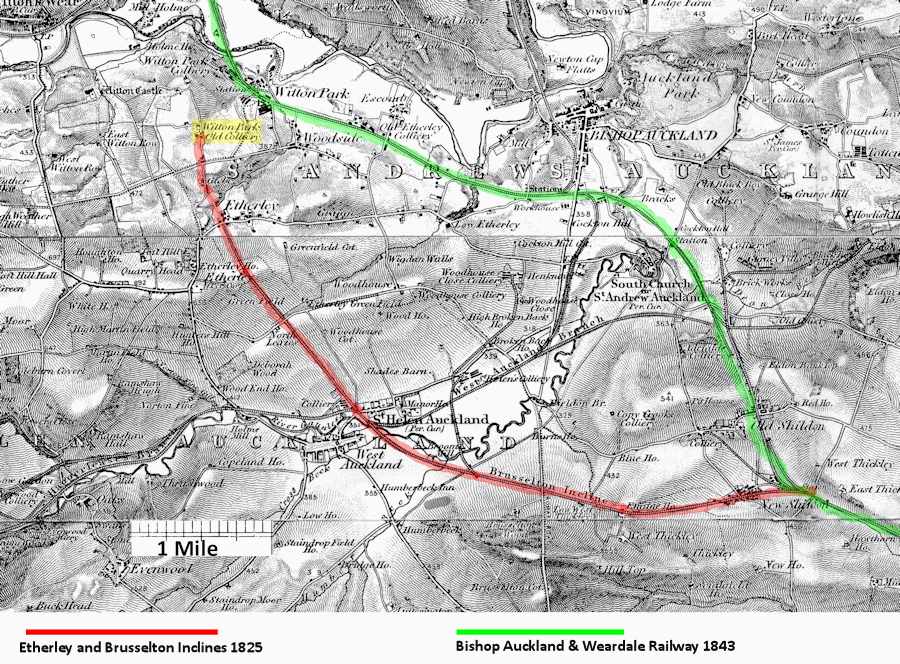

Witton Park
Etherley Top
River Gaunless
Brusselton Top
Shildon
Route profile from Witton Park to Shildon
The stationary engines7 were installed in time for the opening of the Stockton & Darlington Railway in 1825.
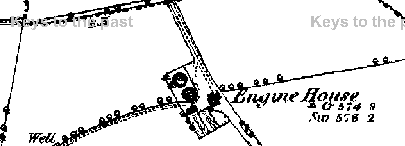
Plan of Etherley Top Engine House - the enclosure is now a disused orchard.
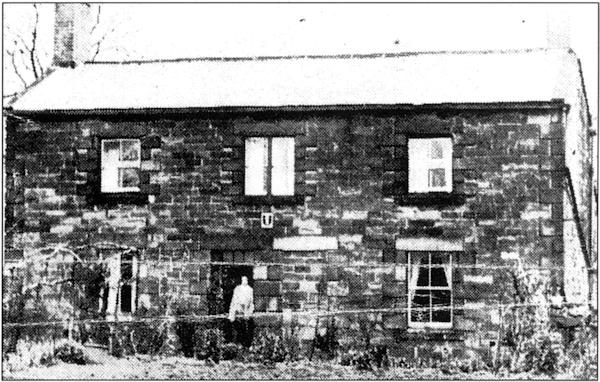
Etherley Engine-man's Cottage
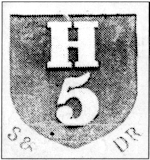
Company plaque over cottage door.13
It was not until 1842 that a railway tunnel was driven between Shildon and Bishop Auckland allowing the construction of the Wear Valley Railway, connecting to directly to Witton Park (and beyond), in 1843. A branch to West Auckland was opened in 1856 linking to the Haggerleases Railway, superceding the use of the Brusselton incline to haul coals from the Gaunless valley.
Question - when was the Etherley incline last used? I have been passed information (150 Years of Steam??) "that when the tunnel and line went through Bishop Auckland and Whitton [sic] Park the Brussleton Incline was abandoned but the inclines at Etherley had to be kept open". However John Wall in "First in the World" (2001)states the reverse (which seems to be more reasonable). 11 The '1861' 1:10560 OS map shows the Etherley Incline as a 'disused railway' (with no railway track) but the Brusselton Incline track is shown. This supports John Wall's information that the Etherton Incline closed first, presumably in 1843.
Colin E. Mountford14 states
"In 1827 the Railway had opened the Black Boy branch from Shildon northwards to collieries south of Bishop Auckland. This too incorporated two inclines worked by a stationary engine. In 1842 the Shildon Tunnel was opened, thus avoiding these inclines, and on 8th November 1843 the Bishop Auckland & Weardale Railway, a subsidiary of the Stockton & Darlington Railway, opened its line from Bishop Auckland to Crook via Witton Park, thus making the Etherley inclines redundant, although some traffic may have continued to take the old route. "
"The increasing traffic from the Haggerleazes branch led to the Stockton & Darlington building what was called the 'Tunnel Branch', a new line from St.Helens Auckland to the northern end of Shildon Tunnel. This was opened on 13th September 1856, making the Brusselton inclines redundant. In fact the passenger service over the inclines continued to operate, and not until 13th October 1858 were both the Brusselton and Etherley Inclines officially closed."
This still leaves a question mark over the use of the Etherley Inclines from 1843 to 1856. The Etherley and Brusselton stationary engines were advertised for sale in 1858
Question - Phoenix Row has been said to be built on the line of the Etherley Incline10 - when was it built? Phoenix Row is shown on the '1861' OS map mentioned above.

Etherley incline & engine house: 1875
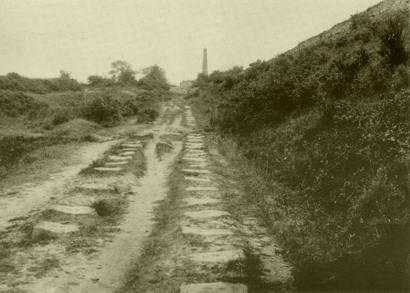
Note that the rails were laid on stone sleeper blocks rather than wooden sleepers.
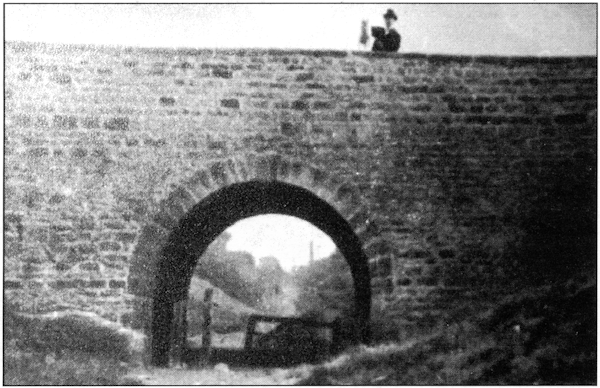
The bridge carrying the Etherley Road (B6282) over the incline.
(Now destroyed).
"The Proprietors of the above concern hereby give notice that their main line Railway, commencing at Witton Park Colliery, in the west of this county and terminating at Stockton-on-Tees on the east, with several branches at Darlington, Yarm, etc., being about 27 miles in extent will be opened for the general purposes of trade, on Tuesday, the 27th inst..........A superior Loco Motive Travelling Engine, of the most improved construction, will be employed with a train of convenient carriages, for the conveyance of the Proprietors and strangers.Any gentleman who may intend to be present on the above occasion will oblige the Company by addressing a note to their office in Darlington as early as possible.
Stockton & Darlington Company's Office
September 14th, 1825. "
The western terminus of the Stockton and Darlington Railway was at Witton Park colliery - variously stated to be at Jane Pit, Phoenix Pit or William Pit.
A more detailed account of the route from Witton Park Colliery and Stockton-on-Tees will be found at http://www.rsf.org.uk/routes/england05.htm (cached)
Notes
1 Witton Park History http://www.tomorrows-history.com/projects/PJ0100300001/Witton%20Park%20History.htm An event that changed the world. 27th of September 1825, a landmark date in the history of England and the world. The opening of the Stockton Railway. The first public railway to use steam powered locomotives, carrying a few passengers, whose main purpose was taking the black gold, coal from the South Durham coalfields to the River Tees at Stockton and from there to the world market. The western terminus of the line was the William Pitt, Witton Park.
2 Haggerleazes Railway Company http://www.haggerleases.co.uk/history_1.html - Description of the start of the Stockton and Darlington.
3 Bateman genealogy - Witton Park coal had been promoted for sale since 1774 using engravings by the Dixon family of Cockfield but industry at Witton Park did not take off until 1825. The Chaytor family had earlier bought Witton Castle and Witton Park Colliery in 1815 but quickly sold it to a Mr. McLean MP making a good profit which they invested in the new Stockton and Darlington Railways along with co-investor, Joseph Pease of Darlington. When McLean filed for bankruptcy, William Chaytor bought Witton Castle and Colliery back. It was Chaytor who persuaded the Stockton and Darlington Railways to employ George Stephenson to build the first public railway which was to start at Witton Park colliery. In fact Lockomotive Number One started at Shildon but this was only because the train could not get over the hill between Witton Park and Shildon. The coal wagons were pulled by horses up the hill [incorrect - stationary engines were used] and held by ropes down Etherley Incline until secured to the Locomotive Number One at Shildon. The first coal left Jane Pit at Witton Park by railway in 1825, and 17 years later after completing the necessary tunnel the Locomotive Number One was able to pull up outside of Jane Pit.
4 Account of Boring made at the Foot of the Etherley Incline. 1826 http://www.dmm.org.uk/shaftsm/0000-809.htm . Not yet discovered exactly where.
5 The old railway line here is on the route of the world's first passenger railway, built by the Stockton & Darlington Railway Company. On the morning of 27th September 1825, 12 wagons of coal left Phoenix Pit. The wagons were horse-drawn for the first part of their journey, then hauled up Etherley North Incline by stationary steam engines. At Shildon, the wagons were attached to George Stephenson's Locomotion along with several additional wagons carrying passengers. http://www.geograph.org.uk/photo/1719632
6 Cabry, Thomas: Born New York (Northumberland, near Whitley Bay) on 6 June 1801, died York 1 September 1873. Worked for Robert Stephenson. Assisted in erection of stationary engines on Stockton & Darlington Railway at Brusselton and Etherley in 1824/5. http://www.steamindex.com/people/cabry.htm
7 Power from steam: a history of the stationary steam engine By Richard L. Hills p142
The use of fixed engines to drag trains on railways by ropes was introduced by Cook in 1808. George Stephenson in his youth worked on a winding engine at Willinington Quay for dumping ships' ballast. He built two two-cylinder low pressure beam engines for hauling wagons up the inclines on the Stockton & Darlington Railway which were installed ready for the opening in 1825. The order was placed in 1823 and Stephenson undertook to
erect two 30-horse engines combined on one axle at Brusselton hill-top ..... for £3,482.15.0 and also another engine at Etherley hill-top, two engines each of 15 horse-power combined o one axle for the sum of £1,982.15.0 ..... The two boilers for the first named engine to be 8 feet diameter by 20 feet long and the boiler for the Etherley engine to be of the same dimensions ..... The size of the working cylinders to be 30 inches [60 in stroke] for the Brusselton engine and for the Etherley engine 22 inches [36 in stroke].
While the engine for the Etherley incline was said to have been originally intended for a steam boat and so was a side-lever type with the reciprocating beam placed below the vertical cylinders, that for Brusselton and those in subsequent orders were conventional beam engines.
8 http://www.railcentre.co.uk/stockton/opening.htm
On opening day the Company's rolling stock consisted of one locomotive, one passenger coach, and 150 wagons.
"Locomotion" was brought from Newcastle by road and placed on the rails at Heighington (Formerly, Aycliffe Lane), a short distance from Shildon. The station buildings carried the number "G2". From this view the building looks to be small, however the view is deceiving, for due to the falling ground, the photograph in fact shows the upper storey, which was used as the offices.
"Locomotion" was taken back to Shildon to be attached to the train.
From daybreak, thousands of people collected on the slopes of the ridge at Brusselton to see the working of the sixty h.p. stationary engine.
Shortly after 7o'clock, twelve wagons of coal were led from the Phoenix Pit to the foot of the Etherley Ridge and drawn up the North Bank by the stationary engine situated at the top. They were lowered down the Etherley South Bank to the road at St. Helens, Auckland, where they were joined by another wagon filled with sacks of flour. The wagons were then led by horses across the flat to the foot of Brusselton West Bank. At 8 o'clock, the loaded wagons, further burdened by several people, were drawn up the incline, and thence lowered down the eastern side of the ridge, to the awaiting "Locomotion" and 21 wagons fitted with seats and the passenger coach "Experiment".
9 Sheet 103 of the 1" Ordnance Survey, republished by David & Charles, NW quarter, was printed originally in 1866. It shows the Etherley and Brusselton Inclines, but the railway stops at the road at Etherley (I.e. the modern B6282) while the embankement continues down to the 'Phoenix Row' of cottages.
10 From 'Wikipedia' http://en.wikipedia.org/wiki/Phoenix_Row
Phoenix Row incorporating Belts Gill and Softley Dene Farm (formerly Glebe Farm) is a tiny village of about 30 houses in County Durham, in England. It is situated half a mile north of Low Etherley and 2.5 miles west of Bishop Auckland. It was built on the abandoned line of George Stephenson's original Etherley Incline railway, designed to haul coal by static steam engine from the Witton Park collieries to join the locomotive-driven section of the Stockton & Darlington Railway at Shildon in 1825. As such it has a visible but largely unrecognised importance in railway history.
The hamlet of Phoenix Row was built in the 1840s, originally of local sandstone, Stobart brick and red pantiles to house families of miners and farmworkers. Nearby Witton Park Iron Works also provided some employment until its closure. The people of Phoenix Row built their own Methodist Chapel (now a private house) and they had a cricket team which played at the New Inn Fields. Phoenix Row's bracing climate was credited in the local press for breeding tall, strong sportsmen - "sturdy six-footers". At one time the majority of the houses in the hamlet were occupied by members of just three families - Watsons, Grays and Stubbs - and their in-laws.
In the 1960s Phoenix Row was threatened with the dreaded Category "D" notice, a death sentence for many post-industrial County Durham villages. However the determined villagers fought the Category "D" notice tooth and nail. Showing remarkable community spirit, they united under the banner of PRIDE (the Phoenix Row Improvement & Development Effort) and succeeded in getting the threat lifted, modernising their homes and saving their village for future generations.
'Phoenix Row' appears in the 1861 census as 'Venture Row', consisting of 25 Dwellings. In 1871 and subsequent censuses it is named Phoenix Row - though spelled Phenix Row in 1881 and mis-transcribed as Phsennis Row in 1891. I cannot find it in the 1851 census - but I cannot find Glebe farm either (Bishop Auckland district 11e pp10-23. Part of Etherley is also in Escombe, district 23, pp39-55)
11 'First in the World' by John Wall 2001 (A History of the Stockton and Darlington Line)
"From 1856 locomotives reigned supreme and the era of inclines was no more."
"From the opening of the Bishop Auckland and Weardale railway on 8 Nov 1843, therefore the Etherley Inclines to West Auckland were made redundant. The OS map of 1861, which was surveyed between 1855 and 1858, indicates that by this time the track of the Etherley Incline had been lifted."
"The Brusselton Inclines continued in operation to serve the collieries of the Gaunless Valley. ... the Brusselton incline was abandonned in 1858 ..."
12 According to 'The Chronicle of the Stockton and Darlington Railway to 1863' (John Proud 1998) p38 "the STB [Shildon Tunnel Branch between South Church and St Helen Auckland] was opened on the 13th of September 1856. As a consequence the route over the Brusselton incline was closed."
13 "One interesting and individualistic feature of the Stockton & Darlington Railway was its systematic numbering of railway houses. They were identified by letters signifying areas and by serial numbers within each area. Thus F10 is to be seen on a house near the now disused Barnard Castle station and Ki is on the small cottage at Crawleyside quarry, whilst K8 is on the old station house at Waskerley. Each letter and number was set up in a black and white ceramic built into the upper wall of the house" (The Stanhope and Tyne Railway by Frank Atkinson).
14 "Rope and Chain Haulage - The Forgotten Element of Railway History" Colin E. Mountford. Published by the Industrial Railway Society 2013. ISBN1901556841
This book has 3 pages (81, 84, 85) and five illustrations describing the Etherley and Brusselton Inclines.
15 The 1825 Stockton & Darlington Railway:
Historic Environment Audit
Appendix 1. Witton Park to St Helen Auckland. October 2016
Archaeo-Environment for Durham County Council, Darlington
Borough Council and Stockton Council
(This publication appeared after my note above was prepared. My
note has not been cross-checked or updated from the historic
environment audit.)